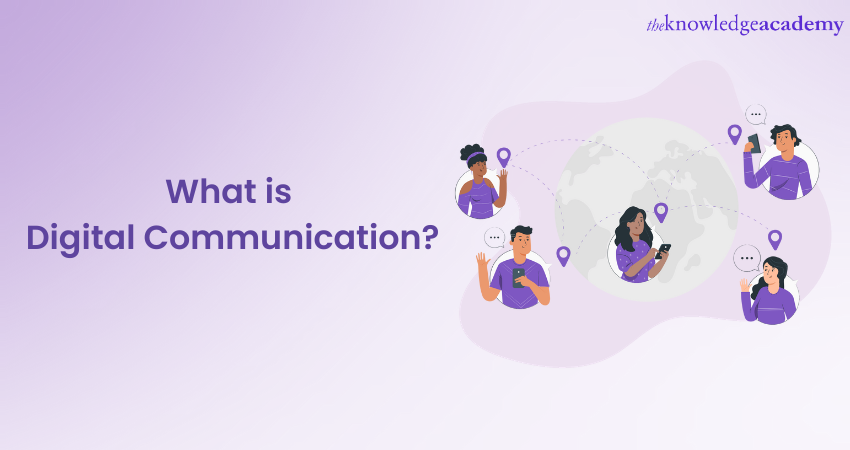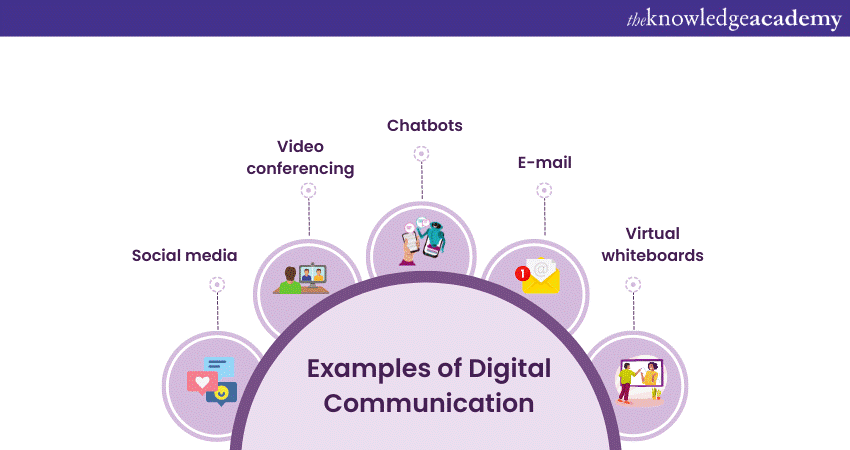We may not have the course you’re looking for. If you enquire or give us a call on 01344203999 and speak to our training experts, we may still be able to help with your training requirements.
Training Outcomes Within Your Budget!
We ensure quality, budget-alignment, and timely delivery by our expert instructors.

A decade back, one might not even have had a slight idea about What is Digital Communication. Digital Communication has since then emerged as a powerful tool that connects individuals and organisations across the globe. It has revolutionised how we interact, collaborate, and share information and opened up endless possibilities by eliminating geographical boundaries.
According to Statista, 54 per cent of the respondents said there is an increased focus on Digital Communications in their organisation after Covid-19. In this blog, you will learn What is Digital Communication is and its key elements, along with some examples. Continue reading to find out more!
Table of Contents
1) What is Digital Communication?
2) Why is Digital Communication important?
3) Key elements of Digital Communication
4) Common career paths in Digital Communication
5) Examples of Digital Communication
6) Conclusion
What is Digital Communication?
Digital Communication is the process of exchanging information, messages, and ideas using digital technologies and platforms. It involves the transmission and reception of data through electronic devices and networks. Digital Communication enables real-time interaction, instant messaging, video conferencing, and sharing of multimedia content across vast distances.

Why is Digital Communication important?
The potential of Digital Communication was highlighted during the pandemic time. Businesses without a Digital Communication strategy failed to survive during that time. Video conferences became the channel of communication, emails became the new normal way of conveying messages.
Digital Communication is also important for various other reasons as well which are given below:
a) Better engagement of workers
b) Comfortable and convenient experience
c) Universally acceptable
d) Transparency within the organisation
e) Saves time, energy and money
Key elements of Digital Communication
Digital Communication possesses a range of unique features that distinguish it from traditional communication methods. Understanding these key features is essential to fully grasp the power and capabilities of Digital Communication. Let's explore some of its significant features:

Instantaneous interaction
One of the defining features of Digital Communication is its ability to enable immediate and real-time interaction. Whether it's through instant messaging, video calls, or live chat, Digital Communication allows individuals to connect and communicate with each other instantly, transcending geographical barriers.
Multimedia integration
Unlike traditional communication methods that primarily rely on text-based messages, Digital Communication seamlessly integrates various multimedia elements. Users can share and receive photos, videos, audio recordings, and other forms of media to enhance their communication and convey messages more effectively.
Asynchronous and synchronous communication
Digital Communication offers the flexibility of both asynchronous and synchronous communication. Asynchronous communication allows individuals to send messages and receive responses at their convenience, such as through email or social media posts. On the other hand, synchronous communication enables real-time conversations through platforms like video conferencing, where participants can engage in discussions without delays.
Accessibility and convenience
Digital Communication has significantly increased accessibility and convenience. With the proliferation of smartphones and internet connectivity, people can engage in communication anytime and anywhere. Whether it's sending a quick message during a commute or participating in a virtual meeting from a remote location, Digital Communication provides unprecedented convenience and flexibility.
Collaboration and co-creation
Digital Communication facilitates collaboration and co-creation among individuals and teams. Through shared documents, cloud-based platforms, and collaborative tools, people can work together on projects, share ideas, and contribute to a collective effort, regardless of their physical location.
Data preservation and archiving
Unlike traditional forms of communication that are often transient, Digital Communication allows for easy preservation and archiving of conversations and exchanges. This feature enables individuals and organisations to keep records of important discussions, references, and decisions for future reference and accountability.
Personalisation and customisation
Digital Communication empowers users to personalise and customise their communication experiences. Individuals can choose their preferred communication platforms, tailor notifications, and customise settings to align with their specific needs and preferences.
Scalability and reach
Digital Communication has the ability to scale and reach large audiences effortlessly. Social media platforms, for example, enable individuals and businesses to communicate with thousands or even millions of followers simultaneously. This scalability broadens the reach and impact of communication efforts, making it an invaluable tool for marketing, information dissemination, and community engagement.
Integration with other technologies
Digital Communication seamlessly integrates with various technologies, like Artificial Intelligence, Virtual Reality, and Augmented Reality. These integrations open up new possibilities for immersive and interactive communication experiences, transforming how individuals and businesses connect and engage with one another.
Global reach
Digital Communication provides a platform for global connectivity. People can connect with individuals, organisations, and communities from all corners of the world with just a few clicks. This global reach fosters collaboration, knowledge sharing, and cultural exchange on an unprecedented scale.
Understanding these key features of Digital Communication helps us harness its power to its full potential. As technology keeps evolving, we can expect further advancements and innovations that will shape the future of communication.
Become more assertive with our Assertiveness Skills Training. Join now to enhance your communication and confidence.
Common career paths in Digital Communication
The scope of Digital Communication is plenty in today’s fast-paced business world. Few of the career paths in this field are discussed below:
Digital Strategy
To get the best return for the efforts you put in, it is advised to use a strategic method while using digital marketing. The job roles consist of planning, creating, sharing and analysing content that resonates well with the business plan. Digital strategy involves creating a roadmap which makes sure that everyone in the organisation including stakeholders has a clarity of the strategy.
Content Executive
The main job of a Content Executive is planning, creating and sharing content to engage the audience. They are responsible for engaging the audience or raising awareness about a particular product or service.
Email Marketing
This is a timeless strategy that will be relevant forever. These roles require the understanding of communication, based on the interests of customers as it involves sending them customised emails. The importance of segmentation and classification of customers is also emphasised here.
Data-driven Marketing
These roles are expected to make marketing moves by analysing and interpreting data for the campaigns. They also play an important role in abiding by the compliance and other regulatory requirements revolving around the privacy of an individual. Understanding of digital tools is an important skill to advance a career in data-driven marketing field.
Search Engine Optimisation (SEO)
In this role, professionals are expected to implement and analyse website content and other technical features to ensure the company’s search engine ranking. SEO professionals need to understand the latest features like voice assistance and AI to make the content reach the targeted users.
Social Media
They are responsible for carrying out marketing and promotions using social media platforms. It can be in any form ranging from a piece of writing to a long-format video. It is important to understand the target audience rather than invest a huge amount on the production side. The marketing should go well with the company’s brand identity. It is a platform where a company can convert a target audience to a trusted customer. Explore how understanding the principles of communication enhances effectiveness across these diverse digital communication career paths.
Examples of Digital Communication
Digital Communication has revolutionised the way we connect, collaborate, and share information in our daily lives. Let's explore some key Digital Communication examples that highlight the power and impact of Digital Communication:

a) Instant messaging: Platforms like WhatsApp, Facebook Messenger, and Slack enable us to exchange messages in real time, facilitating quick and efficient communication.
b) Video conferencing: Tools like Google Meet, Zoom, and Microsoft Teams have transformed remote communication by allowing face-to-face interactions and virtual meetings.
c) Social media platforms: Facebook, Twitter, Instagram, and LinkedIn connect people globally, enabling them to share updates, engage in discussions, and build networks.
d) Email: It remains a widely used example of Digital Communication method, providing a formal and reliable means of exchanging messages and files.
e) Collaborative tools and cloud storage: Platforms such as Google Drive and Dropbox allow users to collaborate on documents in real-time, enhancing teamwork and productivity.
f) Social networking platforms: Twitter and LinkedIn offer avenues for professional networking, knowledge sharing, and industry engagement.This is one of the best Digital Communication Examples business can utilise to build a loyal customer base.
g) Mobile applications: Mobile apps enable communication on the go, providing instant access to messaging, social media, banking, and other services.
h) Remote collaboration: Tools such as project management software and virtual whiteboards facilitate seamless collaboration among remote teams.
i) Online learning platforms: E-learning platforms and tools enable students and educators to communicate, access resources, and participate in virtual classrooms.
j) Online customer support: Many companies provide customer support through live chat and chatbots on their websites, offering prompt assistance.
These examples demonstrate the diverse ways in which Digital Communication has transformed our personal and professional interactions. By leveraging these tools and platforms, we can easily connect, collaborate, and share information, irrespective of physical distance. For more insights into the theoretical frameworks shaping communication, explore various models of communication that underpin these digital interactions.
Learn how to effectively plan and manage call centre resources with our Call Centre Management Training - Signup now!
Conclusion
Digital Communication has revolutionised how we connect and collaborate. Embracing its potential transcends boundaries, fosters relationships, and unlocks opportunities. Leverage the power of Digital media and communication in order to thrive in this interconnected world. Hope you have understood What is Digital Communication through our comprehensive blog.
Elevate your communication game and embark on a journey of growth and success with our Communication Skills Training – Signup today!
Frequently Asked Questions
Upcoming Business Skills Resources Batches & Dates
Date
 Public Speaking Course
Public Speaking Course
Fri 9th Aug 2024
Fri 25th Oct 2024
Fri 27th Dec 2024
Fri 28th Feb 2025
Fri 11th Apr 2025
Fri 27th Jun 2025
Fri 22nd Aug 2025
Fri 24th Oct 2025
Fri 28th Nov 2025







 Top Rated Course
Top Rated Course


 If you wish to make any changes to your course, please
If you wish to make any changes to your course, please


